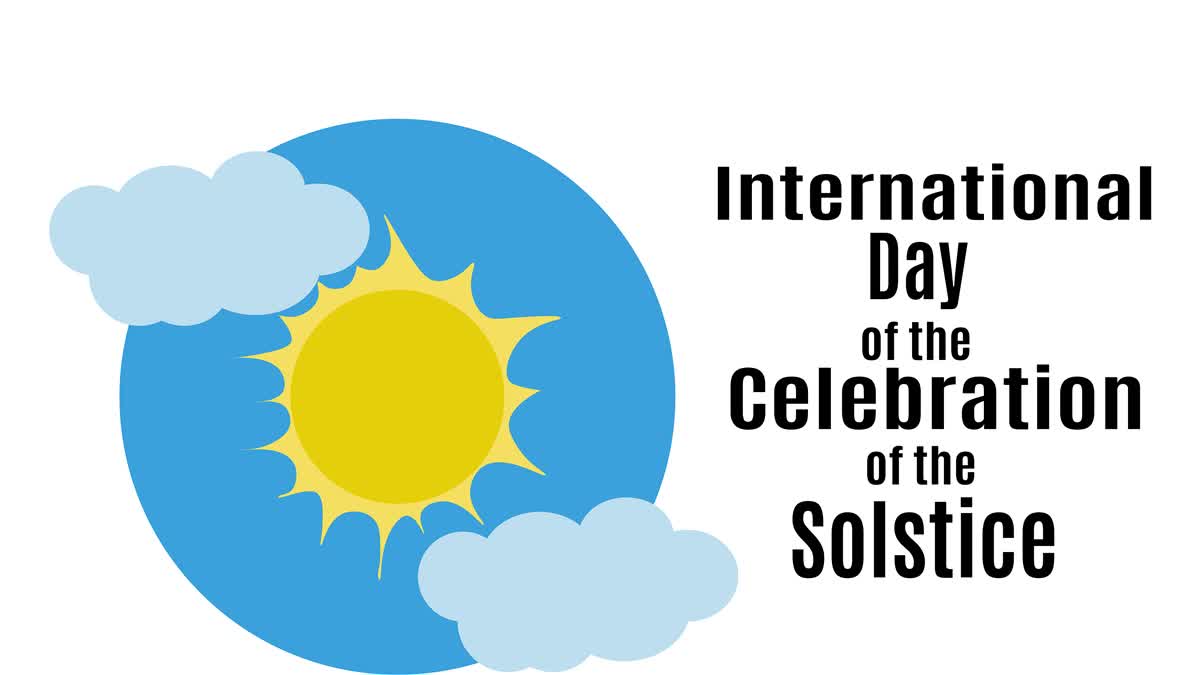Hyderabad: Every year, June 21 is marked as the day of the summer solstice in the northern hemisphere of the world, where summer is in the middle of the year, as opposed to the southern hemisphere where summer lies in December.
What is Summer Solstice: The summer solstice, a celestial dance between Earth and the Sun, holds a special magnetism. It’s a moment etched in time, the longest day of the year in one hemisphere and the shortest in the other, a pivot point where seasons embrace and transform.
What Causes The Sun's North-South Movement?: The Sun's north-south movement relative to Earth is due to our planet's axial tilt. This tilt means that Earth's axis is tilted about 23.5 degrees from vertical. As Earth revolves around the Sun, the direct sunlight shifts between the Tropic of Cancer and the Tropic of Capricorn, causing the seasons. The hemisphere tilted towards the Sun experiences summer, while the other hemisphere experiences winter.
History of Observing Summer Solstice: In approximately 200 BC, Eratosthenes is said to have observed sunlight shining straight down the shaft of a well during high noon on the solstice, near the modern-day Egyptian city of Aswan.
What is The Age of The Sun?: The Sun is 4,500,000,000 years old.
Why Is June 21 Longest Day Of The Year In India?:
On June 21st, the Northern Hemisphere is tilted towards the sun. The rays of the sun fall directly on the Tropic of Cancer.
As a consequence, those areas receive extra heat. The areas near the poles get less heat (as the rays of the sun are slanting). The North Pole is inclined towards the sun & the places beyond the Arctic Circle experience continuous daylight for almost 6 months.
As a large area of the Northern Hemisphere is receiving light from the sun, it is summer in the regions north of the equator. The longest day & the shortest night at these places occur on 21st June.
The Summer Solstice happens when the Northern Hemisphere is tilted closest to the Sun. This occurs around June 21st each year. On this day, the sun's rays hit the Northern Hemisphere more directly than any other time of the year. Because of this, the Sun appears at its highest point in the sky. This leads to the longest day and the shortest night of the year. In India, this means we have more daylight hours than any other day of the year.
When Will Summer Solstice Happen in India?: As per NASA, the official date is June 20 at 4:50 PM EDT. But in the case of India, it will happen on June 21.
Places On Earth Where The Sun Never Sets!: Our routine revolves around 24 hours a day, with around 12 hours of sunlight, and the remaining hours are night time. But, did you know that there are places across the world where the sun does not go down for more than 70 days? Imagine how interesting (or confusing) it would be for tourists to keep a track of time, when even the locals there get confused with no sunset for straight 70 days! .
Why Doesn't The Sun Set in Some Parts of The World?: Around the time of the summer solstice, areas of norway, finland, greenland, alaska and other polar regions experience midnight sun - or 24-hours of sunlight.
In the Arctic Circle, the Sun does not set at all. This is because of the tilt in the Earth's axis.
The Earth’s Distance From The Sun: NASA says that the Earth’s distance from the sun is typically 93 million miles (150 million km). According to Almanac.com, Earth will be the furthest from the sun on 6 July 2023, at 4:06 pm EDT (1:36 am IST), when it will be 94,506,364 miles (152,093,251 kilometres) away. This is known as the aphelion. This is roughly two weeks following the June solstice.
Similar to this, according to LiveScience, Earth will reach its perihelion, or closest point to the sun, on 2 January 2024, at 7:38 pm EDT (5:08 am IST), two weeks after the December solstice. At this time, Earth will be 91,404,095 miles (147,100,632 km) from our star.
Here is How Different Countries Celebrate The Summer Solstice:
India (Mass Yoga Sessions): In India, people come together for mass yoga sessions at dawn to greet the solstice sun. It’s a tradition that comes from the belief that it was on summer solstice that Adiyogi (the first yogi) met his disciples, who would help him bring the practice of yoga to different parts of the world. The mass yoga events on summer solstice, some of which are attended by more than 100,000 people, take place in cities across the country.
England (Stonehenge): Each year, thousands gather at England’s famous Stonehenge to watch the sunrise. Stonehenge is an intriguing pre-historic stone circle, which has puzzled archeologists and historians for centuries. On the summer solstice, the stone circle is precisely aligned with the rising and setting sun. It’s believed that solstices have been celebrated here for thousands of years. In fact, the celebration of the summer solstice may have been the very reason why Stonehenge was built.
Russia (White Night): Known as White Night in Russia, the festival is celebrated with pomp and splendour. Firework displays are on show, along with musical concerts and a Scarlet Sails event, in which huge ships sail across the Neva River with bright red sails.
Norway (Slinningsbålet): In Norway, the festival is celebrated as Slinningsbålet, where bonfires are lit to honour the birth of John the Baptist. These fires are said to cleanse the air of evil spirits.
Sweden (Midsommar): In Sweden, the summer solstice or “midsommar”, as the Swedes sayis a widely celebrated national holiday. With summery songs, crowns of flowers, breezy white dresses and flowery maypoles to dance around, Sweden’s traditional midsummer festivals seem to come straight from a fairytale.



